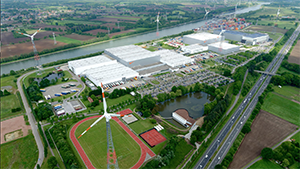The Supply Chain of the Future – NIKE Unveils Advanced, Sustainable Distribution Center
Approximately 50 kilometers outside of Antwerp, amongst green fields and alongside the Albert Canal, Nike’s newly expanded, state-of-the-art European Logistics Campus in Belgium will serve consumers faster as part of a more responsive and sustainable supply chain.
The athletic giant ships more than one billion units of footwear, apparel and equipment every year, which demands an agile, innovative and sustainable supply chain. The expansion will make Nike’s European operations (which employs more than 3,000 people) more efficient, more responsive and more sustainable, enabling growth by serving consumers across Nike.com, Nike retail and wholesale partners in 38 countries, all from a single inventory location.
Sustainable innovation influenced all aspects of the facility, from the drawing board through to final construction, emphasizing Nike’s vision for a low-carbon, closed-loop future as part of the company’s growth strategy.
The Campus sources energy from its surrounding landscape — from five locally generated renewable energy sources, including six 150-meter-high wind turbines (enough to power 5,000 households) and solar panels with a surface area equivalent to three soccer fields. Additionally, more than 95% of waste generated on-site is recycled and transportation routes to and from the campus have been optimized to reduce CO2 emissions by 30%, underscoring Nike’s commitment toward building the supply chain of the future.
Key features of this new facility include:
–The European Logistics Campus uses 100% renewable energy, and sources energy from five locally generated sources: wind, solar, geothermal, hydroelectric and biomass. Six wind turbines on-site produce enough electricity to power 5,000 households, and the on-site solar panels cover the size of three soccer fields.
–The facility is fed by an infrastructure of canals, railways and highways. 99% of inbound containers reach the local container park, by water, not road, saving 14,000 truck journeys a year.
–Moving away from a traditional structure that requires more steel and concrete, the warehouse is a rack-supported building, reducing waste and material used, thereby minimizing its footprint.
–More than 95% of waste generated on-site is recycled. Pathways used by employees around the facility are made from recycled footwear material.
–Natural light provided by many windows, a unique daylight capture system and smart, automated LED lighting help to reduce electricity costs, reduce environmental impact and provide a more productive workplace.
–The facility was carefully designed to expand while supporting biodiversity. For example, sheep will help naturally maintain the landscaping, and on-site beehives will contribute to biodiversity through the pollination of flowers around the facility and in the local area.
View an interactive graphic of the facility.





